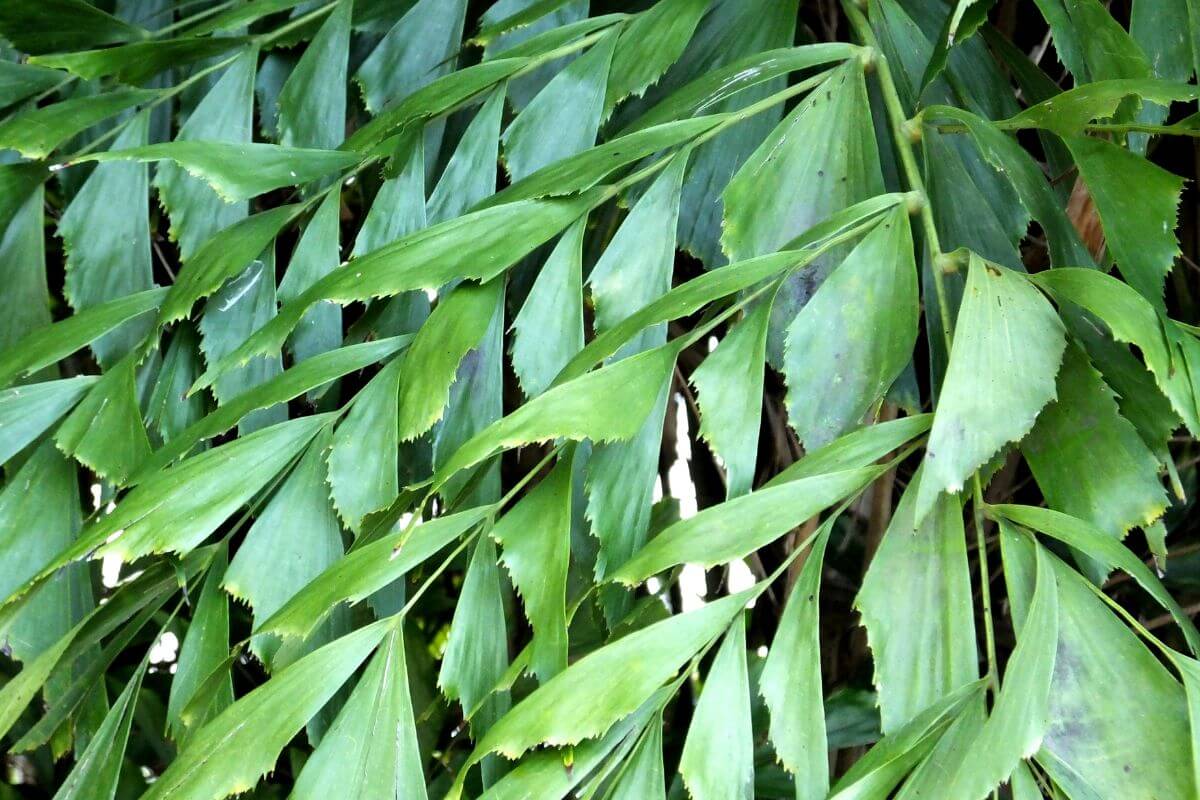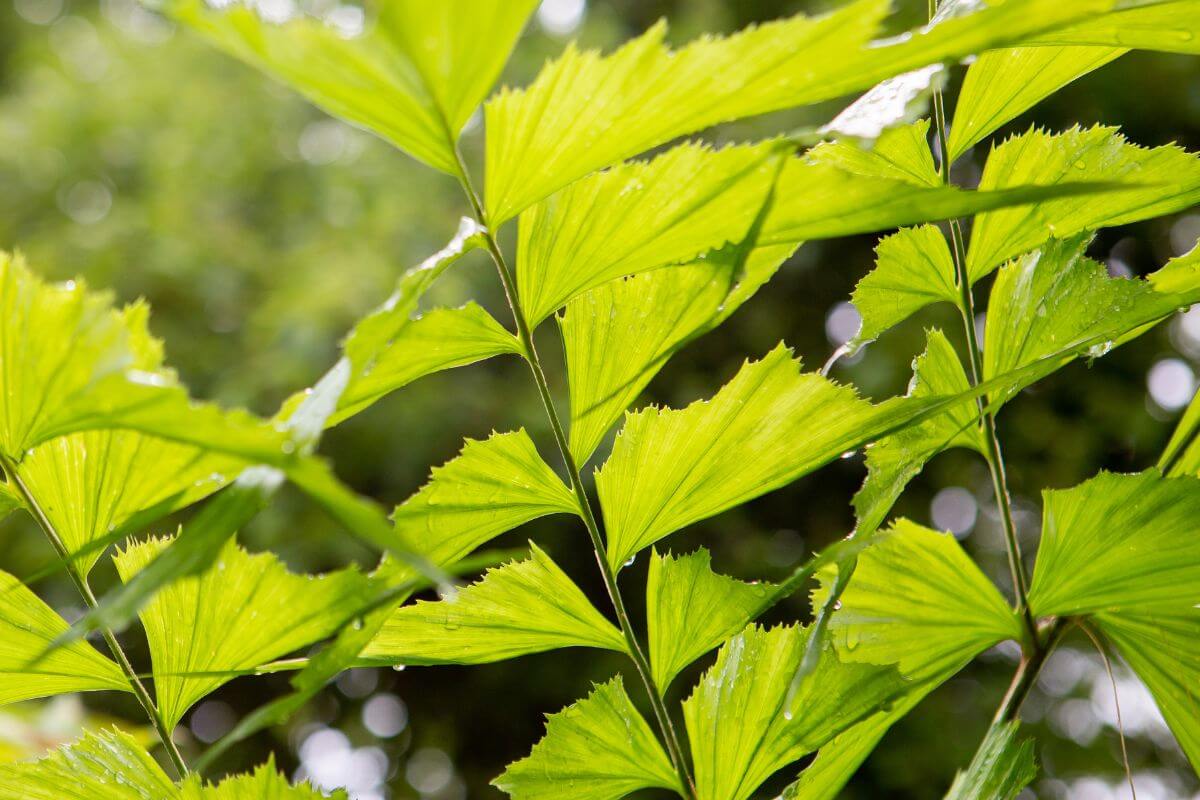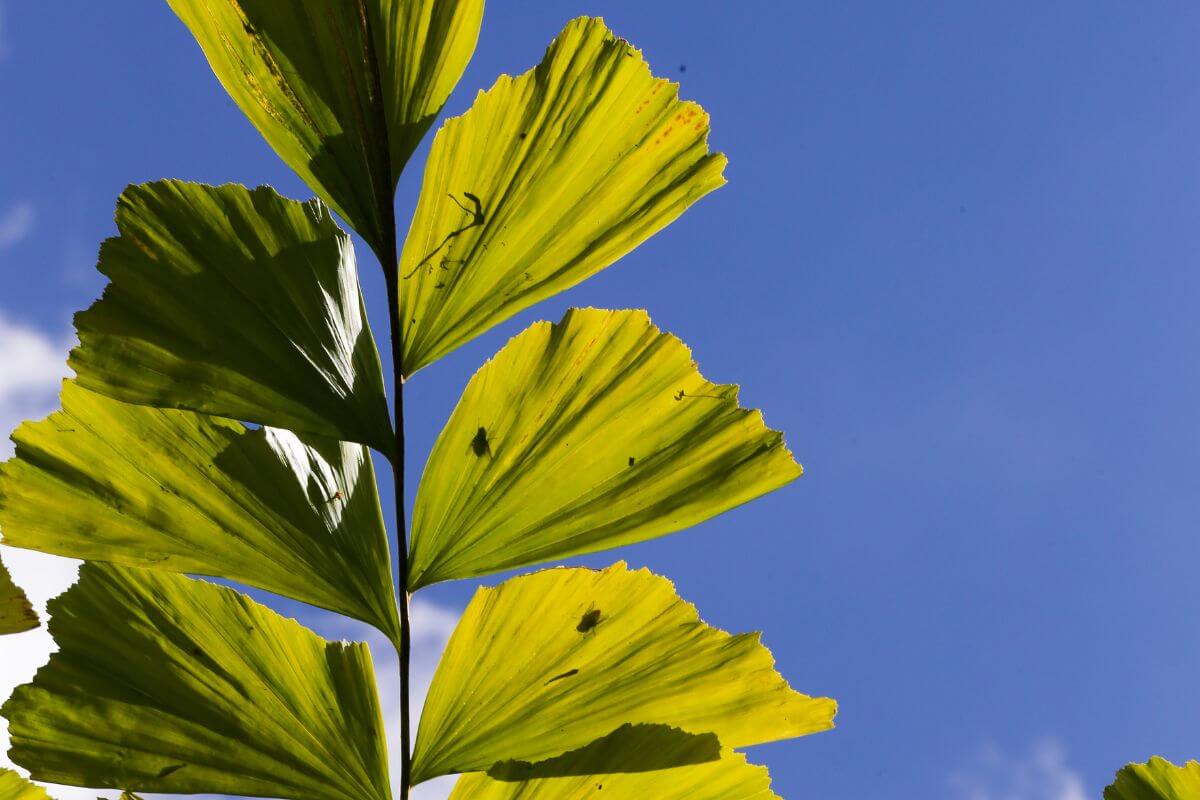The fishtail palms are beautiful palm trees that make for great plants around the home. They are well known for their unique fishtail shaped leaves.
If you want to grow fishtail palms, then you should know that there are certain things that you need to keep in mind.
This guide will show you everything you need to know about caring for and growing fishtail palms.
Fishtail Palm Tree Overview

A triangular-shaped leaf that appears to split resembles a fishtail. Thanks to the unusual and distinctive appearance of this plant’s fronds, the Caryota mitis enjoys the popular name of the Fishtail Palm.
Its leaves are dark glossy green with edges that appear serrated. An elegant palm plant, it is a member of the Arecaceae family and is native to Asia, Oceania, Pacific Islands, and Australia.
Thanks to its growth in a clump of stems as opposed to a single trunk, this palm plant has a full bush-like appearance. These single trunks will each bloom once in their lifetime, at the end.
In their natural habitat, these palms can grow to approximately twenty-five feet tall with leaves that grow to ten feet long. When cultivated as a houseplant, it will generally reach about five to six feet in height.
Fishtail Palm Care Guide
Environment for the Fishtail Palm

Unless cultivated in USDA hardy zones 10B and 11, this plant is usually grown as an indoor houseplant because it will not tolerate temperatures under 35° Fahrenheit. Palms do not like the cold.
It does not like cold drafts, so a location away from a door, a hallway, air conditioning units, and drafty windows is recommended.
Temperatures should range between 65° and 85° F for best results. If cultivated outside, it cannot tolerate frost or strong wind.
Soil for the Fishtail Palm
Just about any potting soil mix will work, but sand mixed in a three-to-one potting soil to sand ratio will guarantee good drainage that is so fundamental for palms.
If you can find a peat-based soil mix specifically designed for palms, all the better.
Horticultural sand is recommended too. Perlite or tree bark will also work well. Take care that the sand you mix in does not contain salt.
Light for the Fishtail Palm
Your fishtail palm loves light, but it should be filtered and indirect. Positioning your palm near a window or in a location with partial shade will be best.
Eastern and western-facing windows are ideal. You can move your palm outdoors in the summer, but make sure that it is not in direct sunlight.
Water and Humidity for the Fishtail Palm

An indoor fishtail palm will be at risk of overwatering and these palms hate soggy soil. Don’t water unless the top of the soil is relatively dry. This palm will tolerate a dry soil bed better than a wet soil bed.
In the winter, reduce your watering because your palm will be in dormancy and not actively growing. Tap water is heavy with chlorine, fluoride, and other chemicals, so should be avoided. Use distilled water or collected rainwater instead.
The fishtail palm will require a humidity level of 50 percent. Anything lower can create problems for your palm. If you live in a dry climate, you can increase the humidity with a humidifier, grouping plants together, or a pebble tray underneath your palm.
Feeding for the Fishtail Palm
During the growing season, a liquid fertilizer diluted to half-strength should be fed to your plant once or twice. Or you can choose a single feeding with a slow-release fertilizer instead. Getting fertilizer for palms is preferable.
Also, for this palm to thrive, a monthly addition of a pinch of Epsom salt will help prevent your palm from suffering a magnesium deficiency.
Repotting and Pruning the Fishtail Palm
The fishtail palm likes to be a bit rootbound in its pot. Repotting your fishtail palm will be necessary only when you find roots growing out of the container’s drainage holes or soil surface.
Select a new pot that is max two inches larger in diameter than the actual pot. Allowing your palm to be a bit rootbound will help in containing its growth size indoors.
Pruning and removing fronds should only be done when they are dead.
Pruning fronds (leaves) should be avoided because this foliage grows at the stems’ ends. If you trim frond tips, it is likely that growth may stop altogether.
Propagating the Fishtail Palm
Propagation is usually done through seeds. You can sow seeds in the spring in new potting soil. Seeds will germinate if they are lightly covered with soil.
They need to be kept in a warm location at a minimum of 70°F with moist soil. If necessary, you can use a heat mat for seedlings.
Female fishtail palms do produce suckers at their bases, so you can propagate them by removing a sucker from the base. When propagating with a sucker, know that it will take several months for the new plant to develop.
When you remove the sucker, it is similar to plant division, so be sure to remove the plantlet with some roots attached to it. Place your sucker with root in a new container with growing medium, water, and fertilizer, as you would a mature fishtail palm.
Fishtail Palm Pests and Problems

Fishtail palms, like so many houseplants, are at risk for infestations of aphids, scale insects, mealybugs, and whiteflies. Treat an infestation with an organic pesticide as soon as you notice it.
- Related Article: Guide to Organic Pest Control Methods
Should the fronds develop brown tips, it is most likely due to the air being too dry. You’ll want to increase humidity.
The appearance of dark brown or black spots on fronds is usually caused by fungus. Remove or trim affected fronds.
You can also try treating fungal infections with copper fungicide. Ensuring that your palm has bright indirect light and sufficient air circulation will help to prevent fungal infections.
Fishtail palms are at risk for deficiencies of manganese, magnesium, and iron. Discolored fronds are a tell-tale sign. Regular fertilization with a pinch of chelated iron or magnesium should prevent this.
Often, however, a common reason fishtail palms decline is due to inadequate bright light, especially with indoor plants. Give them plenty of bright and indirect light to keep this tropical plant happy.
Fishtail Palm Toxicity and Pets
The fishtail palm and its berries are toxic to dogs and cats due to it containing calcium oxalate crystals.
The fruit or berries can cause allergic dermatitis, so it is recommended that you wear gloves when handling this palm. Avoid touching your eyes after handling the fruit.
If ingested, it can cause irritation and mouth pain, the swelling of the tongue, lips, and throat. Contact your veterinarian if you think your pet has chewed or eaten a part of this palm.
Fishtail Palm Tree Care Final Thoughts
The fishtail palm is a great addition to any home garden. It’s easy to grow, requires little maintenance, and produces beautiful flowers and fruits year round. The leaves have interesting shapes and colors, which make it a popular choice among landscapers.
It does require good sunlight but not much else. A well-drained soil is best suited for this palm tree. Water regularly during hot weather and feed them with palm fertilizer when needed. This palm tree needs very little care other than regular watering and feeding.
Check out these other palm tree care and grow guides for more palms to grow:
Fishtail Palm Tree Care FAQs
How do you take care of a fishtail palm?
Take care of a fishtail palm just like you would a normal palm tree. Keep it watered and fed properly throughout the season. If you live in a dry climate, misting the foliage once every week may be necessary. In colder climates, give it less frequent moisture as it won’t use up the water as quickly.
Are fishtail palms poisonous?
Yes, fishtail palms are poisonous. They contain calcium oxalates, which irritate pets’ mouths and tongues. You must avoid contact between yourself and the fruit or berries. Those berries look delicious, but they contain calcium oxalates. Wear protective clothing while working around the plant.
How big do fishtail palms get?
Fishtail palms can grow to heights of 25 to 30 feet tall outdoors, one of the taller palms. Their trunks can reach 10 inches thick and their branches spread wide enough to cover an entire room, growing up to 10 feet long. As an indoor palm, they’ll usually only reach 5-6 feet tall.
How much light does a fishtail palm need?
The fishtail palm needs at least 6-8 hours of bright indirect light per day. When indoors, place it near a west-facing window or east-facing window. When outdoors, make sure that it’s not in direct sunlight. Place it somewhere it’ll get partial shade.
What kind of soil should I put my fishtail palm in?
A well-draining potting mix is ideal for planting a fishtail palm indoors. Use a mixture of equal parts peat moss, vermiculite, sand, and loam.
Do fishtail palms spread?
Yes, fishtail palms spread by underground rhizomes. These roots will sprout new plants wherever there is adequate space. Plant several seedlings about 2 feet apart from each other. Once established, keep them evenly spaced so that they don’t compete for nutrients. Fishtail palms also produce offsets, small clones of themselves. To prevent overcrowding, remove some of the original plant before replanting its offspring. They are even considered an invasive species in Florida.


